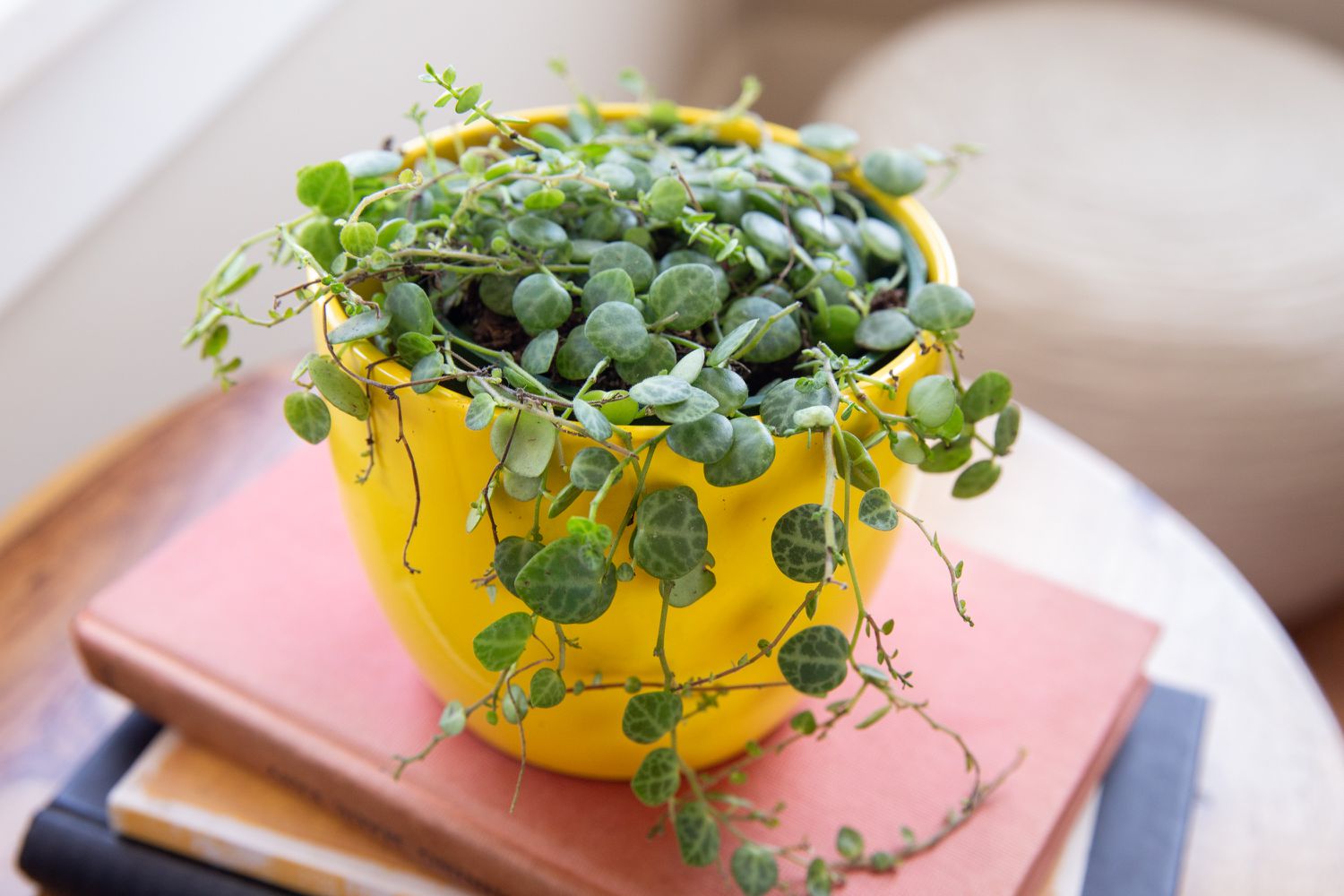To care for string of turtles, place in bright, indirect light and water when soil is dry. String of turtles is a low-maintenance plant that thrives in well-draining soil and warm temperatures.
When watering, allow excess water to drain to prevent root rot. Regularly check for pests like spider mites and mealybugs, and prune any leggy growth to promote bushiness. Consider repotting every 1-2 years to refresh soil and provide more space for growth.
Overall, with proper light, water, and occasional maintenance, your string of turtles plant will flourish and bring a touch of nature into your space.
Ideal Growing Conditions
When it comes to caring for your string of turtles plant, providing the ideal growing conditions is essential for its health and vitality. By understanding the specific requirements for light, temperature and humidity, as well as the appropriate soil and potting mix, you can ensure that your string of turtles thrives in your home environment.
Light Requirements
String of turtles plants thrive in bright, indirect light. Place them near a north or east-facing window to provide the ideal light conditions. Avoid exposing them to direct sunlight, as this can cause burning of the delicate foliage.
Temperature And Humidity Needs
Maintain a consistent temperature range of 60-80°F (15-27°C) for your string of turtles plant. Ensure that the humidity levels are moderate, ideally between 40-60%. Mist the plant occasionally to increase humidity, especially during dry periods.
Soil And Potting Mix Recommendations
Use a well-draining potting mix for your string of turtles, such as a blend of cactus or succulent soil with perlite or pumice. Ensure that the pot has adequate drainage to prevent waterlogged soil, which can lead to root rot.
Watering And Feeding
Caring for a string of turtles requires proper watering and feeding. Water them once a week, ensuring the soil is moist but not waterlogged. Feed them every two weeks with a balanced fertilizer mix and ensure they get enough sunlight.
String of turtles is a unique succulent that is easy to care for, making it a great addition to any indoor garden. Proper watering and feeding practices are essential for its growth and health. In this section, we’ll discuss the watering frequency and method, as well as the feeding schedule and fertilization for this beautiful plant.Watering Frequency And Method
String of turtles is a drought-tolerant plant that can survive for long periods without water. However, it’s important to water it properly to prevent overwatering, which can lead to root rot. The frequency of watering depends on the temperature and humidity of your home, as well as the size of your pot and the amount of sunlight it receives. As a general rule, you should water your string of turtles when the top inch of soil is dry to the touch. This may be once a week or every two weeks, depending on your conditions. When watering, make sure to thoroughly saturate the soil, allowing excess water to drain out of the bottom of the pot. Avoid getting water on the leaves, as this can cause them to rot.Feeding Schedule And Fertilization
String of turtles doesn’t require frequent fertilization, but it can benefit from occasional feedings during the growing season. You can use a balanced, water-soluble fertilizer every four to six weeks, diluted to half strength. Only fertilize when the soil is moist, and avoid feeding during the winter months when the plant is dormant. In addition to fertilization, you can also amend the soil with organic matter such as compost or worm castings to provide the plant with extra nutrients. This can be done once or twice a year, during the spring and fall. In conclusion, proper watering and feeding practices are crucial for the health and longevity of your string of turtles. By following these guidelines, you can ensure that your plant thrives and continues to bring beauty to your indoor garden.Pruning And Propagation
Pruning and propagation are essential aspects of caring for a String of Turtles plant. Proper pruning helps maintain the plant’s shape and encourages healthy growth, while propagation allows you to expand your plant collection or share with others. In this section, we will explore how to effectively prune and propagate your String of Turtles plant.
How To Prune String Of Turtles Plant
To maintain a tidy and compact appearance, pruning your String of Turtles plant is crucial. Start by inspecting the plant for any overgrown or leggy stems. Use clean, sharp scissors or pruning shears to carefully trim these stems back to the desired length. Focus on removing any damaged or yellowing leaves as well. Additionally, regularly pinching back the growing tips of the stems will encourage branching and create a fuller, bushier plant. Remember to discard any pruned material properly to prevent the spread of disease.
Propagation Techniques
String of Turtles plants can be propagated through several methods, including stem cuttings and division. When taking stem cuttings, select a healthy, mature stem and carefully cut it just below a node. Remove any lower leaves to expose the nodes, as these will be the points from which new roots will emerge. Place the cutting in a well-draining potting mix and keep it in a warm, bright location. Regularly mist the cutting to maintain humidity and promote root development. For division, gently remove the plant from its pot and carefully separate the individual stems, ensuring that each division has its own roots. Replant the divisions in suitable containers and provide them with the same care as mature plants.

Credit: www.lovethatleaf.co.nz
Common Issues And Solutions
String of Turtles, with its unique and captivating foliage, can be a delightful addition to any indoor plant collection. However, like any plant, it may encounter some common issues that require attention. Being aware of potential problems and their solutions is crucial to ensuring the health and vitality of your String of Turtles.
Pests And Diseases To Watch Out For
String of Turtles plants are generally resilient, but they can still fall victim to a few common pests and diseases. Vigilance and early intervention are key to keeping your plants healthy and vibrant. Some potential issues to watch out for include:
- Aphids
- Mealybugs
- Scale insects
- Root rot
If you notice any signs of infestation or disease, such as discolored or wilting leaves, sticky residue, or unusual spots, take immediate action to address the issue. Isolating the affected plant and treating it promptly can prevent further spread and damage.
Troubleshooting Common Problems
Despite being relatively low-maintenance, String of Turtles may encounter some common issues that can affect their overall well-being. Here are some troubleshooting tips to address these problems effectively:
- Overwatering: Ensure proper drainage and allow the soil to dry out between waterings to prevent root rot.
- Underwatering: Check the soil moisture regularly and adjust your watering frequency to maintain optimal hydration for the plant.
- Inadequate light: Place the plant in a bright, indirect light location to promote healthy growth and prevent leggy or pale foliage.
- Poor air circulation: Ensure adequate ventilation to prevent the buildup of excess moisture and minimize the risk of fungal issues.
Repotting
Repotting is an essential aspect of caring for your String of Turtles plant. Knowing when and how to repot this unique plant is crucial for its health and growth. By understanding the timing and steps involved in repotting, you can ensure your String of Turtles continues to thrive in its new container.
When To Repot String Of Turtles Plant
It’s important to keep an eye on the root system of your String of Turtles plant to determine when it needs repotting. If you notice the roots starting to grow out of the drainage holes at the bottom of the pot or if the plant becomes root-bound, it’s time to consider repotting. This typically occurs every 1-2 years, especially if the plant has outgrown its current container.
Steps For Successful Repotting
When it’s time to repot your String of Turtles plant, follow these steps for a successful transition:
- Choose the right pot: Select a new pot that is one size larger than the current one, with drainage holes to prevent waterlogging.
- Prepare the new pot: Add a layer of well-draining soil at the bottom of the new pot to provide a healthy foundation for the plant.
- Remove the plant: Carefully remove the String of Turtles plant from its current pot, being gentle with the roots to avoid damage.
- Inspect the roots: Check the roots for any signs of rot or disease, and trim away any damaged or overgrown roots with clean scissors.
- Replant the String of Turtles: Place the plant in the new pot, adding fresh soil around the roots and gently pressing it down to secure the plant.
- Water and care: After repotting, give the plant a thorough watering and place it in a bright, indirect light location to aid recovery.

Credit: plantly.io
Decor Ideas With String Of Turtles
String of Turtles, with its unique foliage, can bring a touch of nature and tranquility to your living space. Incorporating this stunning plant in your interior decor can elevate the aesthetic appeal of your home. Let’s explore some creative ways to showcase and care for your String of Turtles.
Incorporating String Of Turtles In Interior Decor
String of Turtles can be a striking addition to your home decor. Hanging a trailing pot of String of Turtles in a well-lit corner can create an eye-catching focal point. This plant also thrives in a hanging basket or macramé holder, adding a touch of greenery to any room.
Creative Display Options
When it comes to displaying your String of Turtles, the possibilities are endless. Consider placing it in a decorative pot on a shelving unit to add depth and texture to your space. Grouping multiple pots of String of Turtles together can create a lush and vibrant display, bringing life to any room.
:max_bytes(150000):strip_icc()/growing-string-of-turtles-5091591-05-af2ac043a54b4f5182cb719e5fce99ac.jpg)
Credit: www.thespruce.com
Conclusion
In caring for your String of Turtles, remember to provide adequate light, water, and well-draining soil. Regularly check for signs of pests and diseases. Proper pruning and occasional fertilization can help maintain its health and beauty. By following these tips, you can enjoy a thriving and vibrant String of Turtles plant in your home.






Leave a Reply